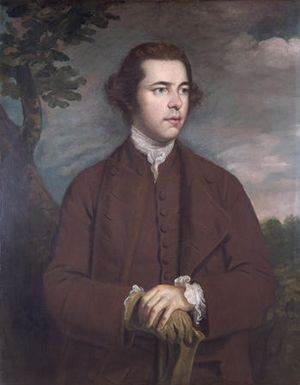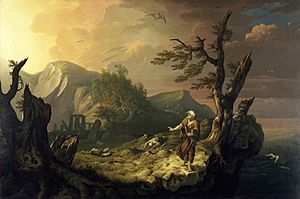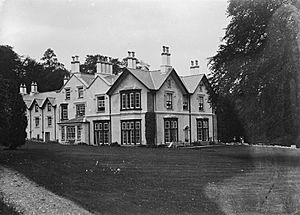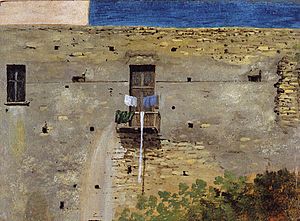Thomas Jones (artist) facts for kids
Thomas Jones (born September 26, 1742 – died April 29, 1803) was a talented Welsh artist. He is famous for painting beautiful landscapes. Thomas Jones learned from a well-known painter named Richard Wilson. For a long time, he was known for paintings that looked like his teacher's style. These showed scenes from Wales and Italy.
However, in the 1900s, people discovered more of Jones's unique artworks. These were not meant for public shows. His paintings of Naples from 1782 to 1783 are especially famous. They were different because he painted what he saw directly, not just following old rules. This new way of painting was very modern for his time. It even reminds us of later artists like Camille Corot. Thomas Jones also wrote a book about his life, called Memoirs of Thomas Jones of Penkerrig. It was published much later, in 1951. This book is now a great source of information about the art world in the 1700s.
Contents
About Thomas Jones
His Early Life and Art Career
Thomas Jones was born in a place called Trefonnen in Cefnllys, Radnorshire. He was the second of sixteen children! His father, also named Thomas Jones, owned land. Thomas grew up on his family's estate, Pencerrig, near Builth Wells. Because of this, people often called him Thomas Jones of Pencerrig. This helped tell him apart from other people with the same name.
He went to school at Christ College, Brecon. Later, he studied at a school in Llanfyllin. In 1759, he went to Oxford to study at Jesus College. His uncle paid for his studies. His uncle wanted him to become a church leader. But Thomas really wanted to be an artist. When his uncle died in 1761, Thomas left Oxford. He then started his journey to become a painter.
Thomas moved to London in 1761. He joined William Shipley's drawing school. He also took classes to draw people. But he still felt he wasn't good enough at drawing figures. So, in 1763, he asked Richard Wilson to teach him. Wilson was a leading landscape painter and also from Wales. Thomas was a lively young man. He wrote in his journal that his teacher once told him and his friends, "Gentlemen, this is not the way to rival Claude!"
In 1765, Thomas Jones began showing his art. He exhibited at the Society of Artists. This group later became the Royal Academy. After 1769, his landscape paintings started to look grander. They became backgrounds for stories from history, books, or myths. He often worked with another artist, John Hamilton Mortimer, who painted the people in his scenes. One of his most famous paintings from this time is The Bard. It is based on a poem by Thomas Gray. The 1770s were a good time for Jones. He became a member of the Society of Artists in 1771. He even served as the society's director in 1773–74. During this time, he also started a special habit. He would paint small landscape sketches in oil on paper. He did these just for fun, not for showing.
His Time in Italy
Thomas Jones had always wanted to visit Italy. He finally went there in September 1776. The paintings he made in Italy were very different from his teacher's style. This was especially true for his watercolour paintings. He used many different shades of blue, which made his art unique. He became friends with other artists living in Italy. These included Jacob More and John Robert Cozens.
His first big art job in Italy was a painting called Lake Albano – Sunset. He painted it for the Earl-Bishop of Derry. This Earl-Bishop became a very important supporter of Jones's art.
Thomas Jones first visited Naples in September 1778. He stayed there for five months. Then he went back to Rome for a while. He lived in a house near the Spanish Steps. In April 1779, he met Maria Moncke. A year later, they moved to Naples together. Naples was the biggest city in Italy then. Jones hoped to find more people to buy his art there than in Rome. He especially wanted to work for the British Ambassador, Sir William Hamilton. Maria and Thomas had two daughters in Naples. Their names were Anna Maria (born in 1780) and Elizabetha (born in 1781).
Returning Home and Later Life
In 1782, Thomas heard that his father had died. After six years in Italy, he was starting to miss home. So, he decided to return to Britain. He, Maria, Anna, and Elizabetha left for London on a ship in August 1783. They arrived in November. Sadly, many of his belongings were ruined by dampness. This included all his painted studies from nature.
In London, Thomas tried to restart his art career. But he didn't need to work as hard. His father had left him an annual income of £300. He did show ten paintings at the Royal Academy between 1784 and 1798. However, by 1785, he felt his time as a full-time artist was over.
In his later years, Thomas Jones felt a strong pull back to Wales. He especially loved his family home, Pencerrig. He inherited the estate in 1787. This happened when his brother, Major John Jones, died without children. With his new financial security, Thomas Jones finally married Maria Moncke on September 16, 1789. His religious mother also encouraged this decision. The wedding took place at St Pancras Church in London.
Thomas took a keen interest in his estate. He used his sketchbook to draw new farming ideas. In 1791, he even wrote a poem called "Petraeia." It was about his love for Pencerrig. (Cerrig means 'stone' in Welsh, and petra is the Greek word for stone.) In 1791, he also became the High Sheriff of Radnorshire. This was an important local role.
Thomas Jones passed away in 1803. He died from a heart condition called angina pectoris. He was buried in his family's chapel at Caebach, Llandrindod Wells.
Pictures of Thomas Jones
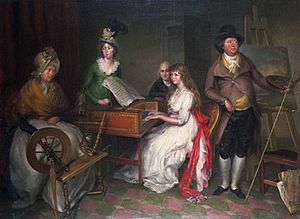
- Giuseppe Marchi (around 1735–1808), Portrait of Thomas Jones, painted in 1768.
- Francesco Renaldi (1755–active until 1798) Portrait of Thomas Jones and his Family, painted in 1797.


